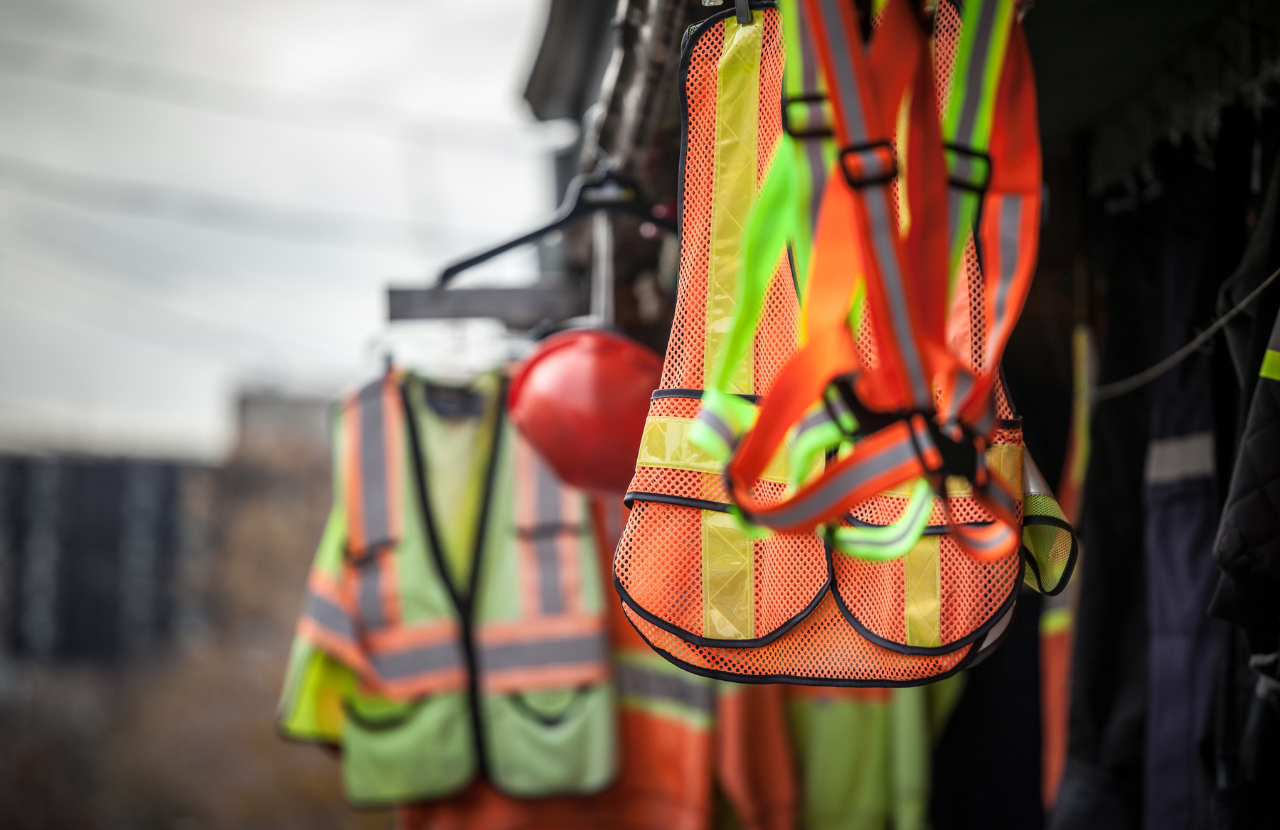
This guide explains what construction PPE is, why it is required under UK law, and what employers and employees must do to ensure it is selected, worn and managed correctly.
Even with effective planning, supervision and control measures, hazards such as falls from height, moving plant, sharp materials and airborne dusts can remain. Construction PPE provides a vital final layer of protection when those risks cannot be fully removed.
What does PPE mean in construction?
PPE (personal protective equipment) refers to items or equipment that employees wear to create a barrier between themselves and hazards. PPE is designed to prevent or reduce injury when risks remain after higher-level risk controls under the hierarchy of control have been applied.
Under the hierarchy of control, organisations should always try to eliminate risks first. Controls should be applied in the following order:
- Eliminate the hazard entirely where possible
- Substitute the material, method or tool for something safer
- Apply engineering controls such as guards, barriers, ventilation or separation
- Introduce administrative controls including planning, safe systems of work, supervision, training, permits and exclusion zones
- Use protective equipment in construction as the last line of defence when risk remains.
Construction sites are dynamic and change constantly, and even with robust planning and control measures in place some risks cannot be removed altogether. PPE provides essential personal protection against those remaining hazards.
Why is PPE in construction mandatory?
Construction site PPE requirements are set out across several pieces of UK health and safety law.
The Personal Protective Equipment at Work Regulations 1992 (as amended by the Personal Protective Equipment at Work (Amendment) Regulations 2022) place a legal duty on employers to provide suitable PPE wherever there is a risk to health and safety that cannot be controlled by other means.
The Construction (Design and Management) Regulations 2015 (CDM) require duty holders to plan, manage and monitor construction work so that it can be carried out safely. This includes making sure that the right control measures are in place for the risks on site.
PPE is a legal requirement on construction sites because it is proven to reduce the severity of injury and prevent avoidable harm when other controls cannot eliminate risk entirely. It reduces the impact of many residual risks, for example by protecting the skull from impact, shielding the lungs from dusts, and reducing the likelihood of foot injuries from dropped loads and sharp objects.
What are a duty holder’s legal responsibilities?
On construction projects, “duty holders” include organisations and individuals who control or influence how work is carried out (such as employers, principal contractors and contractors).
There are specific legal duties that duty holders must meet to ensure PPE is used effectively and compliantly on construction sites. These include:
Assess hazards
Before any construction task begins, employers must identify foreseeable risks (as required under Regulation 6 of the Management of Health and Safety at Work Regulations 1999). This includes assessing the type of work, the environment, the tools and machinery being used, and who may be exposed.
Construction PPE should only be considered after higher level controls have been implemented (see the hierarchy of controls above). The need for PPE should be documented as part of the risk assessment process and reviewed as site conditions change.
Select suitable PPE for construction employees
Under Regulation 4 and Regulation 6 of the PPE at Work Regulations, PPE must be suitable for the risks identified and suitable for the individual who will wear it.
“Suitable” means that it fits properly, is compatible with any other PPE being worn (for example, when combining eye protection with respiratory protection), and is designed for the specific hazard in question.
Duty holders must consider weather conditions, duration of exposure, the level of movement required for the task, and user comfort. For example, cold weather may require thermal protection, hot work may require flame-resistant clothing, and prolonged manual tasks may require lighter, more flexible materials.
PPE must also be CE or UKCA marked where required to demonstrate that it has been tested and meets recognised safety standards. Duty holders should keep records of which PPE has been issued to each employee to support traceability, manage replacement schedules and provide evidence that suitable PPE has been allocated.
Maintain PPE
Regulation 7 of the PPE at Work Regulations requires duty holders to ensure PPE is maintained in an efficient state, in working order and in good repair. This includes ensuring it is cleaned, disinfected (where necessary), stored to prevent damage, inspected at intervals set by the risk assessment and manufacturer guidance, and replaced as soon as it no longer provides adequate protection.
Damaged, ill-fitting or expired PPE cannot protect and should be taken out of use immediately.
Train employees how to use PPE correctly
Regulation 9 of the PPE at Work Regulations requires duty holders to provide information, instruction and training so employees can use PPE correctly and safely. This must be task-specific and proportionate to the risks on site.
Training should cover how to put on, adjust and remove PPE, how to spot wear or defects, how to store equipment, and when it needs cleaning or replacing. Employees must also understand the limitations of PPE (for example, that some RPE filters only protect against specific dusts or vapours).
Employees should be encouraged to report discomfort or poor fit straight away. Uncomfortable PPE is less likely to be worn consistently — and even when it is, poor fit can stop it providing the level of protection intended.
What are an employee’s PPE responsibilities?
Employees have PPE responsibilities under the PPE at Work Regulations and the Health and Safety at Work etc. Act 1974.
Regulation 10 of the Personal Protective Equipment at Work Regulations 1992 places a specific duty on employees to use PPE in accordance with the training and instructions provided to them, and to report any loss, defect, or malfunction without delay.
Section 7 of the Health and Safety at Work Act requires employees to take reasonable care for their own health and safety and to co-operate with their employer on health and safety matters, which includes wearing PPE when instructed.
Basic construction PPE
Although the exact requirements will vary by task and location, there is a core range of PPE for construction that is required on most UK sites:
- Safety helmets (hard hats) – protect the head from impacts and falling objects
- High-visibility vests or jackets – ensure employees can be clearly seen by vehicles, plant and colleagues
- Protective footwear (usually with steel or composite toecaps and anti-slip soles) – reduce the risk of foot injuries from crushing, penetration and slips
- Task-specific gloves – protect hands from hazards such as cuts, chemical burns, vibration, heat and abrasion
- Eye protection (such as safety glasses or goggles) – prevent injuries from debris, dust, sparks and splashes
In addition to this standard baseline, many activities require more specialised PPE including:
- Hearing protection for high noise environments
- Respiratory protective equipment (RPE) where there is exposure to hazardous dusts, vapours or fumes such as silica, welding fume or asbestos
- Fall protection equipment (such as harnesses and lanyards) when working at height
- Arc flash or flame-resistant clothing for electrical work and certain hot work activities
Every item of construction PPE must be selected based on the specific hazard it is intended to control, and must be suitable for the task, the conditions and the individual wearing it.
Prevent avoidable injuries with IOSH Approved PPE Training
Our IOSH Approved PPE Training gives employees the knowledge to select, wear and maintain PPE correctly in line with UK legislation and recognised best practice.
By increasing PPE competence, organisations can reduce the likelihood of avoidable injuries, improve compliance with the Personal Protective Equipment at Work Regulations 1992, and avoid costly replacements due to misuse or poor maintenance.
PPE Training can be tailored to your organisation, and it is available as eLearning, face-to-face at a venue of your choice, or via a virtual classroom. Find out more on our website, or contact our friendly team on 0203 011 4242 / info@praxis452.com

Adam Clarke
Managing Director (Consulting)
